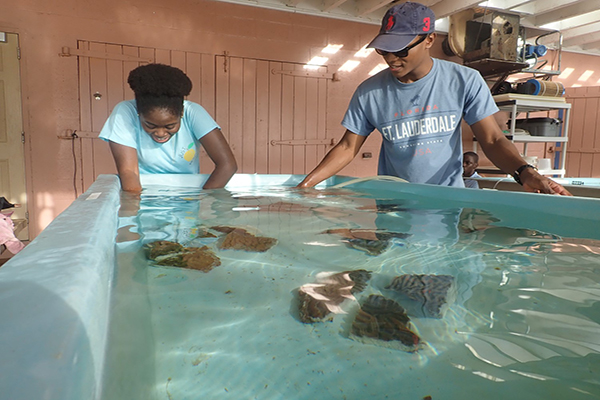
A newly published study from scientists at the University of the Virgin Islands (UVI) and The University of Texas at Arlington (UTA) examines how different coral species respond to a devastating disease and which species are more vulnerable. The project examines the effects of stony coral tissue loss disease (SCTLD), which first appeared in 2014 in the waters around Florida and began spreading to the Caribbean in 2018-19.
Dr. Marilyn Brandt, UVI Research Professor of Marine Science and Dr. Laura Mydlarz, UTA Professor of Biology, led the research effort in collaboration with colleagues from Mote Marine Laboratory, Woods Hole Oceanographic Institution, Louisiana State University, and Rice University. The paper, “Stony coral tissue loss disease induces transcriptional signatures of in situ degradation of dysfunctional Symbiodiniaceae,” was published in the May 22 edition of Nature Communications. Kelsey Beavers, a Ph.D. student in Mydlarz’s lab, is the lead author of the study.
SCTLD is a devastating, rapidly spreading disease characterized by rapid tissue loss and high mortality rates in coral. It has affected corals along the entire 350-plus miles of Florida’s Coral Reef and in 22 Caribbean countries and territories, including the U.S. Virgin Islands and Puerto Rico.
Brandt’s laboratory at UVI led the disease transmission experiment, while Beavers from Mydlarz’s lab examined gene expression in five coral species from the experiment in order to understand which are more susceptible to the disease, which are affected more severely and how fast the disease spreads in specific coral.
“There is no identified pathogen for stony coral tissue loss disease, yet it is deadly to more than 20 different types (species) of corals. We wanted to compare how the different species reacted to the disease thinking that if we could find commonalities among the responses, it would give us clues to how the disease works and maybe even help to identify a pathogenic agent,” Brandt said.
“We did see a difference in species susceptibility that provided this amazing framework for gene expression, and we found this new potential mechanism of this disease that is the coral getting rid of its own symbionts,” Mydlarz said. “The symbionts provide the food and the energy for the coral.”
A symbiont is an organism living in a mutually beneficial relationship with another organism. In this case, the symbiont is Symbiodiniaceae, which are algae that live inside coral. The coral provides a safe home for the symbiont, which in turn uses sunlight to produce food for the coral.
The researchers found that SCTLD infection causes an increased expression of the gene rab7, which has been found in corals to be involved in a process called symbiophagy, where coral will digest dead or dysfunctional symbionts.
“Basically, this is the first disease where we’ve found that the coral may actually be mounting a response against this symbiont instead of just a general immune response,” Beavers said. “This indicates that the symbionts that typically live happily inside the coral and give it energy could actually be the source of the disease.”
“The symbiosis between the coral and the algae is fundamental to the growth and survival of coral reefs. There has been some suggestion that the disease is targeting the symbionts, but this work is the first to provide solid evidence. Knowing this helps the scientific community better focus its research efforts on identifying a pathogen and finding better interventions to fight the disease,” said Brandt.
Data gathered during the study showed that in addition to trying to digest their own symbionts to get rid of them, the corals are also undergoing some measure of starvation.
“We found lots of lines of evidence implicating the symbiont as the source, because the symbionts are also experiencing stress in their photosynthesis, either going haywire or just turning off,” Beavers said. “Also, most likely as a consequence of that, we see genes indicative of starvation in the coral. So, if they’re not getting food from their symbiont, it would make sense that they’re having starvation responses.”
Mydlarz noted that the severely high mortality rates among corals have prompted scientists to take drastic measures. This includes removing healthy corals from reefs before disease can strike them and transporting them to aquariums, zoos or other facilities where they’ll be safe. Some corals from Florida have even ended up at the Fort Worth Zoo.
Co-authors of the study include Marilyn Brandt, Sonora Meiling, and Tyler Smith from UVI as well as other members of Mydlarz’s lab. Researchers from Mote Marine Laboratory, Woods Hole Oceanographic Institution, Rice University and Louisiana State University also contributed to the project.
The study was funded by two grants from the National Science Foundation.
For more information, contact pr@uvi.edu.